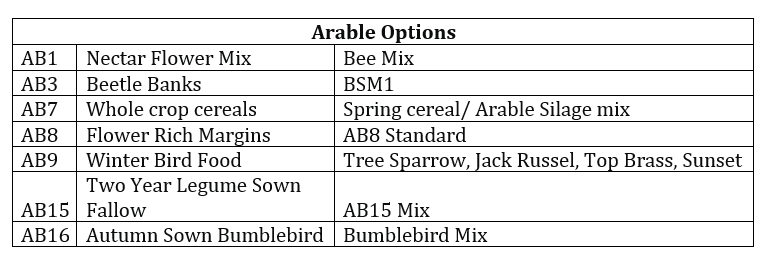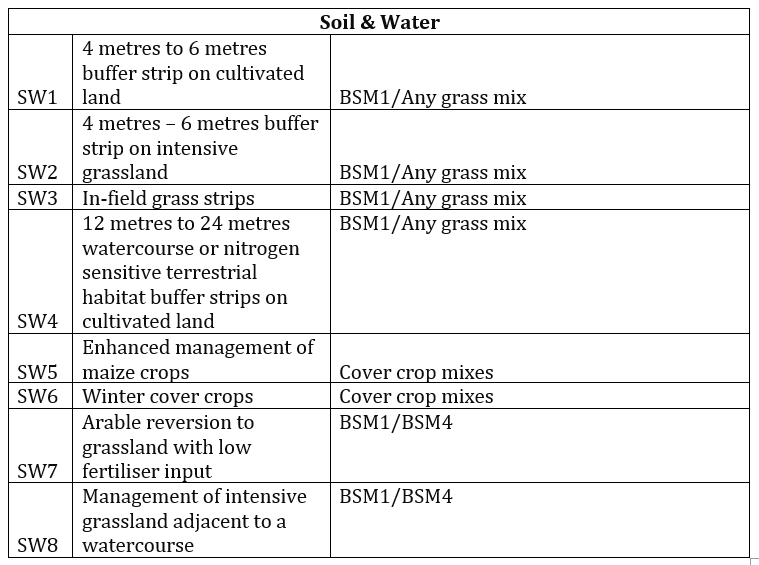Environmental options
AB1: Nectar flower mix
It provides areas of flowering plants to boost essential food sources for beneficial pollinators.
Key Points:
You must establish in blocks or strips between 1 March and 15 September
Sow a grass-free seed mix which contains a minimum of 6 flower species.
A seed mix which contains both shorter-lived legumes and longer-lived wildflower species
At least 2 of these must be from the following list.
o Common knapweed
o Musk mallow
o Oxeye daisy
o Wild carrot
o Yarrow
AB1: Beetle Banks
Why?
It provides nesting and foraging habitats for pollinators, beneficial insects which feed on crop pests, small mammals and some farmland birds.
Key Points:
Sow a mixture of fine-leaved grasses such as red fescue together with some tussock-forming varieties like tall fescue, timothy and cocksfoot.
This will be established during the first year and maintained for the duration of the agreement.
Cut the established mixture to control woody growth and suckering species.
https://www.gov.uk/countryside-stewardship-grants/beetle-banks-ab3
AB8: Flower-rich margins and plots
Why?
Flower-rich grass margins or plots provide important habitat and foraging sites for invertebrates (including wild pollinators) and birds.
Key Points:
Establish flower-rich margins and plots between April/May and early September (mid to late summer is usually the best time to sow wildflowers)
The seed mix will contain a minimum of 4 grass species and 10 wildflower species
https://www.gov.uk/countryside-stewardship-grants/flower-rich-margins-and-plots-ab8
AB9 - Winter bird food
Why?
It provides important food resources for farmland birds, especially in autumn and winter.
Producing an abundant and available supply of small seeds during the autumn and winter months
The flowering plants will benefit insects.
Key points:
During the spring or summer - between 15 February and 15 June- the seed mix, will be established in blocks or strips of at least 6 metres (m) wide and between 0.4ha and 5ha in size
It need to contain at least 6 small seed-bearing crops (not maize)
Annual mixtures can include a range of cereal, brassica or other small-seeded crops.
Seed mixes may contain a maximum of 3 of the following cereal crops - barley, oats, rye, triticale and wheat
Make sure a single crop group, such as cereals or brassicas, is not more than 90% of the total seed mix by weight.
Include biennial crops such as kale, stubble turnip or teasel in 2-year mixtures.
Structural crops that predominantly provide cover, and/or support for weaker stemmed crops such as barley and millet (which can be prone to lodging), can be included in the seed mix
https://www.gov.uk/countryside-stewardship-grants/winter-bird-food-ab9
AB15: Two year sown legume fallow
Why?
It provides food for farmland wildlife, such as pollen and nectar for pollinators. It can also be a useful part of a rotation aimed at reducing blackgrass populations.
Key Points
In the spring/summer/autumn, sow a mixture containing 6 flowering species and retain for 2 years before re-establishing
You can also include grasses such as cocksfoot, perennial ryegrass or timothy in seed mix to help smother blackgrass and other competitive grass weeds
https://www.gov.uk/countryside-stewardship-grants/two-year-sown-legume-fallow-ab15
AB16 -Autumn sown bumble bird mix.
Why?
It provides important food resources for farmland birds and a range of nectar feeding insects, including butterflies and bumblebees, on arable and mixed farms.
Key points:
Establish as soon as possible after harvest and before 15 September, in year 1 and year 3 of your
Retain until 15 August in the second summer after sowing.
A seed mix should contain at least 6 flower species and 6 seed-bearing crops (with seed mixes containing a maximum of 3 cereal crops from barley, oats, rye, triticale and wheat)
This option works well on most soil types and, as with conventional crops, there will be more seeds and flowers produced where it is located on better ground. Ideally, pick sheltered sites that face south or west for maximum benefits to pollinators.
It also works on heavier soils where spring-sowing of winter bird food plots is difficult.
https://www.gov.uk/countryside-stewardship-grants/autumn-sown-bumblebird-mix-ab16
GS4 – Legume and herb rich sward
Why?
A vigorous sward with abundant legumes and herbs, suitable for productive cattle and sheep, will also provide habitat and food for invertebrates, including crop pollinators, and improve soil structure and water infiltration.
Key points
Establish a mixed sward of grasses, legumes and herbs and wildflowers in the first 12 months of the agreement.
Make sure that the seed mix sown contains at least 5 species of grass, 4 species of legume and 4 species of herb or wildflower.
Make sure the sward has a minimum 20% cover of other legumes and herbs (not counting white clover, creeping buttercup or injurious weeds)
Manage the sward by cutting or grazing.
https://www.gov.uk/countryside-stewardship-grants/legume-and-herb-rich-swards-gs4
*information correct at time of writing






